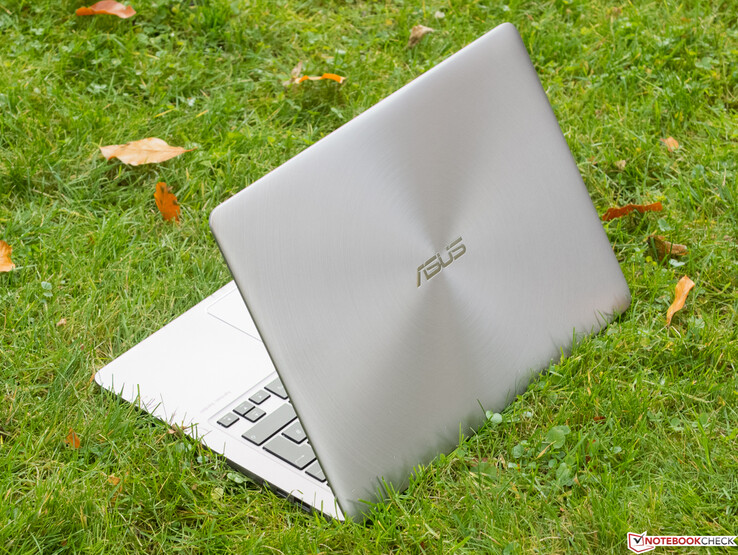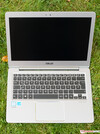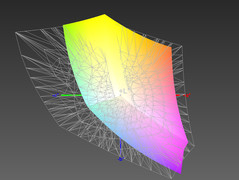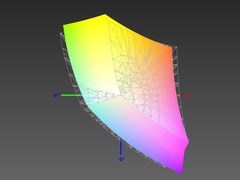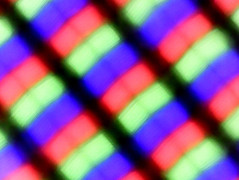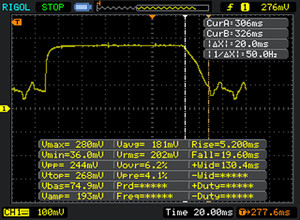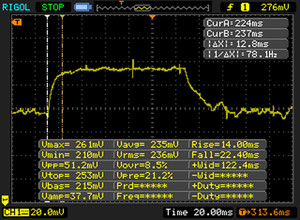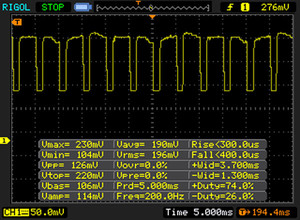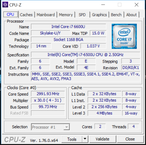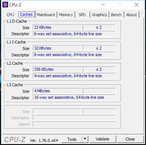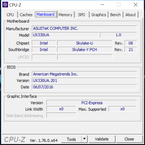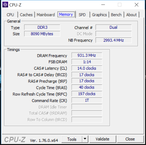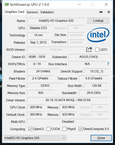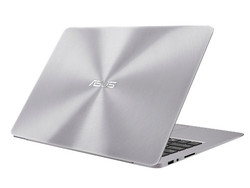Breve Análise do Portátil Asus Zenbook UX330UA
Os Top 10
» Os Top 10 Portáteis Multimídia
» Os Top 10 Portáteis de Jogos
» Os Top 10 Portáteis Leves para Jogos
» Os Top 10 Portáteis Acessíveis de Escritório/Empresariais
» Os Top 10 Portáteis Premium de Escritório/Empresariais
» Os Top 10 dos Portáteis Workstation
» Os Top 10 Subportáteis
» Os Top 10 Ultrabooks
» Os Top 10 Conversíveis
» Os Top 10 Tablets
» Os Top 10 Smartphones
» A melhores Telas de Portáteis Analisadas Pela Notebookcheck
» Top 10 dos portáteis abaixo dos 500 Euros da Notebookcheck
» Top 10 dos Portáteis abaixo dos 300 Euros
| SD Card Reader | |
| average JPG Copy Test (av. of 3 runs) | |
| Lenovo IdeaPad 710S-13ISK | |
| Asus Zenbook UX305CA-FB055T | |
| Asus Zenbook UX330UA-FC059T | |
| maximum AS SSD Seq Read Test (1GB) | |
| Lenovo IdeaPad 710S-13ISK | |
| Asus Zenbook UX305CA-FB055T | |
| Asus Zenbook UX330UA-FC059T | |
| Networking | |
| iperf Server (receive) TCP 1 m | |
| Asus Zenbook UX330UA-FC059T | |
| Asus Zenbook UX360UA-C4159T | |
| HP Spectre x2 12-a001ng | |
| iperf Client (transmit) TCP 1 m | |
| Asus Zenbook UX360UA-C4159T | |
| Asus Zenbook UX330UA-FC059T (jseb) | |
| HP Spectre x2 12-a001ng | |
| |||||||||||||||||||||||||
iluminação: 86 %
iluminação com acumulador: 360 cd/m²
Contraste: 1636:1 (Preto: 0.22 cd/m²)
ΔE ColorChecker Calman: 5.21 | ∀{0.5-29.43 Ø4.78}
ΔE Greyscale Calman: 6.23 | ∀{0.09-98 Ø5}
90% sRGB (Argyll 1.6.3 3D)
59% AdobeRGB 1998 (Argyll 1.6.3 3D)
65.3% AdobeRGB 1998 (Argyll 3D)
90.6% sRGB (Argyll 3D)
64.2% Display P3 (Argyll 3D)
Gamma: 2.5
CCT: 6506 K
| Asus Zenbook UX330UA-FC059T AU Optronics AUO272D / B133HAN02.7, , 1920x1080, 13.3" | Dell XPS 13-9350 SHP1420, , 1920x1080, 13.3" | Lenovo IdeaPad 710S-13ISK Sharp SHP 1447 / LQ133M1JW15, , 1920x1080, 13.3" | Asus Zenbook UX305CA-FB055T Samsung 133YL04-P02, , 3200x1800, 13.3" | |
|---|---|---|---|---|
| Display | -29% | 5% | -7% | |
| Display P3 Coverage (%) | 64.2 | 44.53 -31% | 66.4 3% | 59.1 -8% |
| sRGB Coverage (%) | 90.6 | 66.8 -26% | 97.5 8% | 85.5 -6% |
| AdobeRGB 1998 Coverage (%) | 65.3 | 45.97 -30% | 68.4 5% | 61 -7% |
| Response Times | -29% | -14% | ||
| Response Time Grey 50% / Grey 80% * (ms) | 32 ? | 52.4 ? -64% | 38 ? -19% | |
| Response Time Black / White * (ms) | 25 ? | 23.6 ? 6% | 27 ? -8% | |
| PWM Frequency (Hz) | 200 ? | 220 ? | 1429 ? | |
| Screen | -6% | -11% | -17% | |
| Brightness middle (cd/m²) | 360 | 277.5 -23% | 344 -4% | 390 8% |
| Brightness (cd/m²) | 337 | 276 -18% | 326 -3% | 352 4% |
| Brightness Distribution (%) | 86 | 88 2% | 87 1% | 81 -6% |
| Black Level * (cd/m²) | 0.22 | 0.191 13% | 0.36 -64% | 0.69 -214% |
| Contrast (:1) | 1636 | 1453 -11% | 956 -42% | 565 -65% |
| Colorchecker dE 2000 * | 5.21 | 4.88 6% | 6.09 -17% | 3.04 42% |
| Colorchecker dE 2000 max. * | 8.85 | 10 -13% | 7.01 21% | |
| Greyscale dE 2000 * | 6.23 | 4.26 32% | 5.36 14% | 2.88 54% |
| Gamma | 2.5 88% | 2.59 85% | 2.01 109% | 2.43 91% |
| CCT | 6506 100% | 6562 99% | 7230 90% | 6848 95% |
| Color Space (Percent of AdobeRGB 1998) (%) | 59 | 41.6 -29% | 62.25 6% | 55 -7% |
| Color Space (Percent of sRGB) (%) | 90 | 65.79 -27% | 97.54 8% | 85 -6% |
| Média Total (Programa/Configurações) | -18% /
-12% | -12% /
-10% | -13% /
-14% |
* ... menor é melhor
Exibir tempos de resposta
| ↔ Tempo de resposta preto para branco | ||
|---|---|---|
| 25 ms ... ascensão ↗ e queda ↘ combinadas | ↗ 5 ms ascensão | |
| ↘ 20 ms queda | ||
| A tela mostra taxas de resposta relativamente lentas em nossos testes e pode ser muito lenta para os jogadores. Em comparação, todos os dispositivos testados variam de 0.1 (mínimo) a 240 (máximo) ms. » 58 % de todos os dispositivos são melhores. Isso significa que o tempo de resposta medido é pior que a média de todos os dispositivos testados (20.2 ms). | ||
| ↔ Tempo de resposta 50% cinza a 80% cinza | ||
| 32 ms ... ascensão ↗ e queda ↘ combinadas | ↗ 12 ms ascensão | |
| ↘ 20 ms queda | ||
| A tela mostra taxas de resposta lentas em nossos testes e será insatisfatória para os jogadores. Em comparação, todos os dispositivos testados variam de 0.165 (mínimo) a 636 (máximo) ms. » 42 % de todos os dispositivos são melhores. Isso significa que o tempo de resposta medido é semelhante à média de todos os dispositivos testados (31.6 ms). | ||
Cintilação da tela / PWM (modulação por largura de pulso)
| Tela tremeluzindo/PWM detectado | 200 Hz | ≤ 80 % configuração de brilho | |
A luz de fundo da tela pisca em 200 Hz (pior caso, por exemplo, utilizando PWM) Cintilação detectada em uma configuração de brilho de 80 % e abaixo. Não deve haver cintilação ou PWM acima desta configuração de brilho. A frequência de 200 Hz é relativamente baixa, portanto, usuários sensíveis provavelmente notarão cintilação e sentirão fadiga ocular na configuração de brilho indicada e abaixo. [pwm_comparison] Em comparação: 53 % de todos os dispositivos testados não usam PWM para escurecer a tela. Se PWM foi detectado, uma média de 8111 (mínimo: 5 - máximo: 343500) Hz foi medida. | |||
| Cinebench R15 | |
| CPU Single 64Bit | |
| Lenovo IdeaPad 710S-13ISK | |
| Asus Zenbook UX330UA-FC059T | |
| Dell XPS 13-9350 | |
| Asus Zenbook UX305CA-FB055T | |
| CPU Multi 64Bit | |
| Asus Zenbook UX330UA-FC059T | |
| Lenovo IdeaPad 710S-13ISK | |
| Dell XPS 13-9350 | |
| Asus Zenbook UX305CA-FB055T | |
| PCMark 8 | |
| Home Score Accelerated v2 | |
| Lenovo IdeaPad 710S-13ISK | |
| Asus Zenbook UX330UA-FC059T | |
| Dell XPS 13-9350 | |
| Asus Zenbook UX305CA-FB055T | |
| Work Score Accelerated v2 | |
| Lenovo IdeaPad 710S-13ISK | |
| Asus Zenbook UX330UA-FC059T | |
| Dell XPS 13-9350 | |
| Asus Zenbook UX305CA-FB055T | |
| PCMark 8 Home Score Accelerated v2 | 3527 pontos | |
| PCMark 8 Work Score Accelerated v2 | 4355 pontos | |
Ajuda | ||
| Asus Zenbook UX330UA-FC059T SanDisk SD8SNAT256G1002 | Dell XPS 13-9350 Samsung PM951 NVMe MZ-VLV256D | Lenovo IdeaPad 710S-13ISK Samsung PM951 NVMe MZVLV256 | Asus Zenbook UX305CA-FB055T Micron M600 MTFDDAV512MBF M.2 | |
|---|---|---|---|---|
| CrystalDiskMark 3.0 | 63% | 106% | 40% | |
| Read Seq (MB/s) | 447.6 | 1097 145% | 1193 167% | 475.2 6% |
| Write Seq (MB/s) | 309.4 | 307.7 -1% | 309.6 0% | 423.7 37% |
| Read 512 (MB/s) | 265.9 | 684 157% | 613 131% | 404.8 52% |
| Write 512 (MB/s) | 275.2 | 308.6 12% | 311 13% | 396.2 44% |
| Read 4k (MB/s) | 18.89 | 38.52 104% | 42.43 125% | 28.57 51% |
| Write 4k (MB/s) | 75.1 | 113 50% | 144.9 93% | 90.7 21% |
| Read 4k QD32 (MB/s) | 142.2 | 244.7 72% | 549 286% | 288.9 103% |
| Write 4k QD32 (MB/s) | 228.9 | 151.5 -34% | 311.3 36% | 242.3 6% |
| 3DMark 11 - 1280x720 Performance GPU | |
| Lenovo IdeaPad 710S-13ISK | |
| Asus Zenbook UX330UA-FC059T | |
| Dell XPS 13-9350 | |
| Asus Zenbook UX305CA-FB055T | |
| 3DMark | |
| 1280x720 Cloud Gate Standard Graphics | |
| Lenovo IdeaPad 710S-13ISK | |
| Dell XPS 13-9350 | |
| Asus Zenbook UX330UA-FC059T | |
| Asus Zenbook UX305CA-FB055T | |
| 1920x1080 Fire Strike Graphics | |
| Dell XPS 13-9350 | |
| Asus Zenbook UX305CA-FB055T | |
| 3DMark 11 Performance | 1626 pontos | |
| 3DMark Ice Storm Standard Score | 60466 pontos | |
| 3DMark Cloud Gate Standard Score | 6081 pontos | |
Ajuda | ||
| baixo | média | alto | ultra | |
|---|---|---|---|---|
| BioShock Infinite (2013) | 57.9 | 31.1 | 26.2 | |
| The Witcher 3 (2015) | 12.3 | |||
| Dota 2 Reborn (2015) | 48.3 | 25.8 | 22.4 | |
| Deus Ex Mankind Divided (2016) | 13.9 |
Barulho
| Ocioso |
| 31.2 / 31.2 / 31.2 dB |
| Carga |
| 37.4 / 41.4 dB |
 | ||
30 dB silencioso 40 dB(A) audível 50 dB(A) ruidosamente alto |
||
min: | ||
(±) A temperatura máxima no lado superior é 42.7 °C / 109 F, em comparação com a média de 35.9 °C / 97 F , variando de 21.4 a 59 °C para a classe Subnotebook.
(+) A parte inferior aquece até um máximo de 38.3 °C / 101 F, em comparação com a média de 39.3 °C / 103 F
(+) Em uso inativo, a temperatura média para o lado superior é 23.7 °C / 75 F, em comparação com a média do dispositivo de 30.8 °C / ### class_avg_f### F.
(+) Os apoios para as mãos e o touchpad são mais frios que a temperatura da pele, com um máximo de 24.3 °C / 75.7 F e, portanto, são frios ao toque.
(+) A temperatura média da área do apoio para as mãos de dispositivos semelhantes foi 28.2 °C / 82.8 F (+3.9 °C / 7.1 F).
Asus Zenbook UX330UA-FC059T análise de áudio
(±) | o volume do alto-falante é médio, mas bom (###valor### dB)
Graves 100 - 315Hz
(±) | graves reduzidos - em média 12.3% menor que a mediana
(+) | o baixo é linear (5.7% delta para a frequência anterior)
Médios 400 - 2.000 Hz
(+) | médios equilibrados - apenas 2.6% longe da mediana
(+) | médios são lineares (5.7% delta para frequência anterior)
Altos 2 - 16 kHz
(±) | máximos mais altos - em média 8.8% maior que a mediana
(+) | os máximos são lineares (6.2% delta da frequência anterior)
Geral 100 - 16.000 Hz
(±) | a linearidade do som geral é média (17.6% diferença em relação à mediana)
Comparado com a mesma classe
» 47% de todos os dispositivos testados nesta classe foram melhores, 7% semelhantes, 46% piores
» O melhor teve um delta de 5%, a média foi 18%, o pior foi 53%
Comparado com todos os dispositivos testados
» 34% de todos os dispositivos testados foram melhores, 8% semelhantes, 58% piores
» O melhor teve um delta de 4%, a média foi 24%, o pior foi 134%
Lenovo IdeaPad 710S-13ISK análise de áudio
(±) | o volume do alto-falante é médio, mas bom (###valor### dB)
Graves 100 - 315Hz
(±) | graves reduzidos - em média 10.8% menor que a mediana
(±) | a linearidade dos graves é média (13.9% delta para a frequência anterior)
Médios 400 - 2.000 Hz
(+) | médios equilibrados - apenas 4.3% longe da mediana
(+) | médios são lineares (5.2% delta para frequência anterior)
Altos 2 - 16 kHz
(+) | agudos equilibrados - apenas 3.6% longe da mediana
(±) | a linearidade dos máximos é média (8.5% delta para frequência anterior)
Geral 100 - 16.000 Hz
(±) | a linearidade do som geral é média (17.9% diferença em relação à mediana)
Comparado com a mesma classe
» 50% de todos os dispositivos testados nesta classe foram melhores, 7% semelhantes, 43% piores
» O melhor teve um delta de 5%, a média foi 18%, o pior foi 53%
Comparado com todos os dispositivos testados
» 36% de todos os dispositivos testados foram melhores, 8% semelhantes, 56% piores
» O melhor teve um delta de 4%, a média foi 24%, o pior foi 134%
Asus Zenbook UX305CA-FB055T análise de áudio
(-) | alto-falantes não muito altos (###valor### dB)
Graves 100 - 315Hz
(-) | quase nenhum baixo - em média 16.3% menor que a mediana
(±) | a linearidade dos graves é média (13.3% delta para a frequência anterior)
Médios 400 - 2.000 Hz
(±) | médios mais altos - em média 5.9% maior que a mediana
(-) | médios não são lineares (20.2% delta para frequência anterior)
Altos 2 - 16 kHz
(±) | máximos mais altos - em média 5.6% maior que a mediana
(-) | os máximos não são lineares (17.5% delta da frequência anterior)
Geral 100 - 16.000 Hz
(-) | o som geral não é linear (47.4% diferença em relação à mediana)
Comparado com a mesma classe
» 99% de todos os dispositivos testados nesta classe foram melhores, 1% semelhantes, 1% piores
» O melhor teve um delta de 5%, a média foi 18%, o pior foi 53%
Comparado com todos os dispositivos testados
» 96% de todos os dispositivos testados foram melhores, 0% semelhantes, 4% piores
» O melhor teve um delta de 4%, a média foi 24%, o pior foi 134%
| desligado | |
| Ocioso | |
| Carga |
|
Key:
min: | |
| Asus Zenbook UX330UA-FC059T 6500U, HD Graphics 520, SanDisk SD8SNAT256G1002, IPS, 1920x1080, 13.3" | Lenovo IdeaPad 710S-13ISK 6560U, Iris Graphics 540, Samsung PM951 NVMe MZVLV256, IPS, 1920x1080, 13.3" | Asus Zenbook UX305CA-FB055T 6Y75, HD Graphics 515, Micron M600 MTFDDAV512MBF M.2, IPS, 3200x1800, 13.3" | Dell XPS 13 9360 QHD+ i7 i7-7500U, HD Graphics 620, Toshiba NVMe THNSN5256GPUK, IPS, 3200x1800, 13.3" | |
|---|---|---|---|---|
| Power Consumption | -15% | -1% | -18% | |
| Idle Minimum * (Watt) | 3 | 3.3 -10% | 4.2 -40% | 6.4 -113% |
| Idle Average * (Watt) | 6.3 | 7.4 -17% | 8.4 -33% | 6.6 -5% |
| Idle Maximum * (Watt) | 7.5 | 8.2 -9% | 8.9 -19% | 6.8 9% |
| Load Average * (Watt) | 36 | 36.5 -1% | 15.9 56% | 27.5 24% |
| Load Maximum * (Watt) | 31.5 | 43.7 -39% | 22.5 29% | 32.4 -3% |
* ... menor é melhor
| Asus Zenbook UX330UA-FC059T 6500U, HD Graphics 520, 57 Wh | Dell XPS 13-9350 6200U, HD Graphics 520, 56 Wh | Lenovo IdeaPad 710S-13ISK 6560U, Iris Graphics 540, 46 Wh | Asus Zenbook UX305CA-FB055T 6Y75, HD Graphics 515, 45 Wh | |
|---|---|---|---|---|
| Duração da bateria | -10% | -29% | 2% | |
| Reader / Idle (h) | 20.4 | 13 -36% | 13.5 -34% | 16.9 -17% |
| WiFi v1.3 (h) | 10.2 | 7.5 -26% | 7 -31% | 6.7 -34% |
| Load (h) | 1.9 | 2.5 32% | 1.5 -21% | 3 58% |
| H.264 (h) | 8.1 | 7 |
Pro
Contra
Embora o novo Asus Zenbook UX360UA-FC059T com um preço de aproximadamente 1100 Euros no momento do teste não passe da marca dos 90 por cento, mais uma vez é um portátil que o escritor gostaria de chamar de seu.
A excelente carcaça chama a atenção, e o peso baixo e as durações extremamente longas se relacionam com um fato móvel excelente. A tela também é totalmente convincente.
Ele oferece um muito bom desempenho do WiFi, as portas posicionadas de forma ideal, e operação silenciosa e fria. Ele também é alimentado impecavelmente e funciona como deveria.
É claro que existem alguns pontos de crítica menores: O teclado poderia ser de melhor qualidade, e não conseguimos nos adaptar bem às propriedades de deslizamento ou às teclas do touchpad. O fraco leitor de cartões de memória é realmente supérfluo; o fabricante somente teve que gastar pouco dinheiro por uma solução adequada.
Nós outorgamos ao novo Zenbook uma recomendação de compra ambígua. Os compradores que se empolgam pela carcaça e que podem viver com um desempenho mais baixo e durações de bateria um pouco mais curtas deveriam dar uma olhada no Zenbook UX305CA com um painel 4K. No entanto, os rivais um pouco mais massivos, pesados, e não tão duradouros da Dell e Lenovo atingiram muito boas pontuações de 90 e 86 %, e ambos possuem suas fortalezas. Por isso, podemos dizer que montamos um campo de teste exaustivo aqui.
Asus Zenbook UX330UA-FC059T
- 11/04/2016 v5.1 (old)
Sven Kloevekorn




